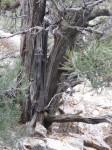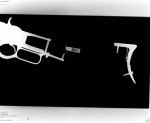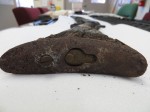 The cracked and weathered Winchester ’73 rifle found leaning against a Juniper tree in Nevada’s Great Basin National Park like its owner just stepped away for a moment 132 years ago and forgot to come back gets more mysterious the more it’s studied. The rifle was found in November of last year by park archaeologists and was sent to the Cody Firearms Museum in Cody, Wyoming, for conservation and additional research.
The cracked and weathered Winchester ’73 rifle found leaning against a Juniper tree in Nevada’s Great Basin National Park like its owner just stepped away for a moment 132 years ago and forgot to come back gets more mysterious the more it’s studied. The rifle was found in November of last year by park archaeologists and was sent to the Cody Firearms Museum in Cody, Wyoming, for conservation and additional research.
When the rifle arrived, the wood of the stock was chipping and a white salt encrusted it. Museum curators first stabilized the wood with a solution of adhesive, distilled water and ethanol and then sent the weapon to nearby West Park Hospital for non-invasive examination of its insides. At the hospital patient “Rifle” — literally, that’s the name on the file — was X-rayed and found to have an object  lodged in its butt stock, namely a cartridge stuck in the trap. To remove the cartridge, conservators lubricated the butt plate with penetrating oil* so it would loosen up enough that it could be unscrewed without damaging the splintered stock. The cartridge was taken out and identified as a Union Metallic Cartridge Company .44 WCF cartridge, manufactured between 1887 and 1911.
lodged in its butt stock, namely a cartridge stuck in the trap. To remove the cartridge, conservators lubricated the butt plate with penetrating oil* so it would loosen up enough that it could be unscrewed without damaging the splintered stock. The cartridge was taken out and identified as a Union Metallic Cartridge Company .44 WCF cartridge, manufactured between 1887 and 1911.
 The Winchester also had an unusual modification. The carrier block and carrier lever are missing. These parts are necessary for the rifle to fire repeatedly, so that means someone deliberately customized the a repeating rifle so that it could only fire a single shot. As a single shot rifle it could still be used for hunting, but it would be less than adequate for personal defense. What the advantage might be to the modification is unclear to me. It’s not like you have to fire back-to-back shots just because it’s a repeater. What’s to prevent hunters from firing one cartridge at a time, if that’s what they want?
The Winchester also had an unusual modification. The carrier block and carrier lever are missing. These parts are necessary for the rifle to fire repeatedly, so that means someone deliberately customized the a repeating rifle so that it could only fire a single shot. As a single shot rifle it could still be used for hunting, but it would be less than adequate for personal defense. What the advantage might be to the modification is unclear to me. It’s not like you have to fire back-to-back shots just because it’s a repeater. What’s to prevent hunters from firing one cartridge at a time, if that’s what they want?
 As far as identifying the owner or even any elements of the story behind the rifle’s century of Rip Van Winkling, that continues to be an enterprise with a very remote chance of success. When the Winchester was first discovered, Great Basin Cultural Resource Program Manager Eva Jensen found the serial number of the lever action repeating rifle listed in the Cody Firearms Museum’s archive of Winchester factory data, but the only information noted was its year of manufacture: 1882. The information of the cartridge shaves five early years off the possible date of the rifle’s abandonment.
As far as identifying the owner or even any elements of the story behind the rifle’s century of Rip Van Winkling, that continues to be an enterprise with a very remote chance of success. When the Winchester was first discovered, Great Basin Cultural Resource Program Manager Eva Jensen found the serial number of the lever action repeating rifle listed in the Cody Firearms Museum’s archive of Winchester factory data, but the only information noted was its year of manufacture: 1882. The information of the cartridge shaves five early years off the possible date of the rifle’s abandonment.
So far nothing else has been discovered to help narrow down the dates. Park archaeologists examined the find site for clues, maybe even human remains, and found nothing. Nor do area records help. Researchers perused fire records to see if there was one in the area. Since there is no evidence of fire damage to the Forgotten Winchester, if there had been fire in there then that the rifle could only have been left leaning against the tree significantly after the flames were doused. They found no recorded fire in the area. Cody Museum researchers are still studying the museum’s vast collection of Winchester company records to see if anything else might be buried in the files.
The Forgotten Winchester is currently drawing crowds at the Cody Firearms Museum where it is on display with another example of the same rifle in good condition so visitors can make a before and after weathering visual comparison. It will stay in Cody until this fall when it will return to Great Basin in time for the park’s 30th anniversary and the centennial of the National Park Service in 2016. After that it will remain on permanent display behind security glass at the Great Basin Park visitor’s center.
*
Sends chills up my spine. What must have the owners story been?
It’s a ghost story waiting to be written.
Conversion to single shot: possibilities
(i) Used for teaching an adolescent to shoot. It would presumably reduce the risk of his accidentally shooting Dad. (I learnt with a five round magazine, sometimes with one round “up the spout”. Dad survived.)
(ii) An economy measure to preserve ammunition.
(iii) Deliberately sabotaged and then provided to an enemy?
(iv) Intended to be used as part of a trip-wire trap?
All entirely plausible. I particularly like the trip-wire trap idea. It suits the drama of the setting.
I think your first 2 points are highly likely – safety, economy, and learning to aim carefully. Most of my friends learned on single shot rifles in the 1950s. My dad let me have a Mossberg with a big magazine (so we wouldn’t have to buy another gun later) but gave me bullets one at a time…
What a sensible, practical approach. You and dearieme are making me think for the first time that a young person may have left that Winchester behind, let’s hope out of carelessness rather than force majeure.
It could have been used as trade with Indians and customized that way as a disadvantage.
It could indeed. I’d hope any prospective buyers would fire a few rounds before making the sale, though.
Hmm. I see what you did there. :p
:giggle:
Possibly scavenged for parts for repairs in the field?
That makes sense too, although would you put the rifle, once scavenged, back together in the field?
lol butt
:giggle:
Aw, you noticed. :blush:
‘Target/Match shooting was extremely popular in the US from about 1871 until about 1917, enjoying a status similar to golf today, and the Winchester company, which had built its reputation on repeating firearms, had in 1885 challenged the single-shot giants of Sharps, Remington …’
(cf. ‘Winchester Model 1885 Single Shot Rifle’).
However, as the cartridge is younger than 1887, a standard pre-1885 rifle could have been customized here for ‘Target/Match shooting’ purposes. Does that make any sense ?
:hattip:
That does! Very much so. Repurposing an old stalwart to join in on the latest fad is something you see in every pursuit.
lols. at the * and fry’s expression. I see what you did there.
Thank you, thank you very much. /Elvis voice
My 30-30, aka 30WCF, is fairly worn and often doesn’t feed properly from the tubular magazine,but still fires.That’s OK for a target shooter like me, but if you need food on the table, a reliable single shot beats a questionable repeater any day.Taking parts out is easy. Fixing them not always. Just my $0.02.
I’ll buy that for a dollar (which would earn you an impressive 98 cents). This is a remote part of the country and people doubtless had to make do with whatever they had on hand.
That’s surely another possibility. But can’t you just leave the lever in place and load one cartridge at a time? If so, you’d save the modification, time unless you needed the mechanism for another gun or could sell it…
I would guess that it was a field-expedient repair of the only weapon some rancher/homesteader/cowboy had available. Why it was left behind is anybody’s guess.
Guess is right. I don’t think we’re ever going to discover the origin story of the Forgotten Winchester.
I think you’re exactly on the money there: This was an old rifle and the missing parts were worn/damaged which prevented the rifle from operating so they were removed by the owner.
My guess is the owner leaned his rifle against a tree and then was unable to find “that tree” again. If you recall when it was found it was hard to see even without foliage on the tree.
It would have stood out more when it wasn’t so greyed and rusted, but yes, I imagine locating that one juniper tree among thousands that has the rifle leaning against it would have been a nearly impossible task if the owner didn’t stay right next to it.
was the cartridge in the stock the only cartridge in the weapon?
Yes.
Yes. Thats how i fire mine right now. But you still have to operate the lever to open and close the bolt and those worn parts still have to move. And will still bind or malfunction.
Reply to comment by alf. Stupid computer!
And penetrating oil… 😆
I bet the gun had worn parts, the riser/carrier and lever removed to to make single shot loading easier, hunter uses it while hunting on an outcrop, shoots a deer, elk or whatever. Waits to be sure the animal is dead, maybe smoke a cigarette while they wait. Finish their smoke, get up to climb down to field dress the kill. After they finish field dressing the kill start back to retrieve the gun but are faced with hundreds of Juniper trees that look like the tree they rested their gun against. Probably looked around for a while, then cussed for a while, the searched and cussed some more and said “Ah F*** it that damn gun was busted anyways.”